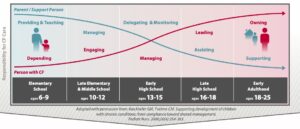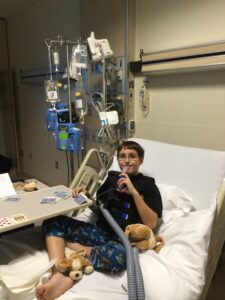by Kristi Gott MSN, RN, PNP-BC
The pandemic year brought many things, not all positive… however, the Pediatric CF team Transition Subgroup used this time to forge ahead in all things transition. As we embark upon this more formally again in the Children’s center as a whole, we hope that sharing our updates with all of you will enhance the work going forward.
Over the course of 2021, we more closely examined the structure and function of our program, deciding where we needed team-facing and patient/family-facing tools. We also scrutinized the flow, form, and framing of our patient’s last year with us through the lens of celebrating accomplishments, polishing skills, and a working toward ‘graduation’ to adult care.
As we all know, it is important to find a place to capture all the work and progress going on with a patient’s transition and transfer in one central place in EPIC. It is hard to sort through interdisciplinary care notes to try to identify what is happening, and even more so when they are seen in another specialty clinic, admitted, or in the ER setting. To make this easier, we developed an EPIC flowsheet (currently in pilot phase) to start capturing all the important transition skills information starting from the age of three and progressing up to the time of transfer between 18 and 21 years of age. We are currently tracking how many of the flowsheets we are starting each month and how many are fully completed prior to the actual transfer of the patient. It has been very fulfilling to start the flowsheet with some of the younger age groups and watch the amount of empowerment and independence that begins to emerge. Likewise, in a patient’s final year of pediatric care, it is rewarding to reflect back with the patient and family how much we have all accomplished together in our care partnership.
Our formal “Meet and Greet” process with the adult CF team went virtual over this time period and we found out that this seems to work well for care team members, as well as our patients and families. We added an evaluation survey to this part of the process that rates the patient’s experience with meeting their new care team. We practice our partnering skills to co-produce agendas for this visit to place them in the “driver’s seat” and help prepare them for working well with the adult CF team. So far scores are showing success! We are in the process of examining the process flow of this to ensure optimal communication and thoughtful timing for all stakeholders.
During the last year of having these young adults in our care, we are honing our attention to detail by covering a variety of topics with them each quarter that will culminate in ‘graduation’. When the final year is initiated, the cohort of patients identified for transfer are moved to an EPIC transition list that is shared with our adult CF team counterparts to allow for joint team preparation and process transparency. We ensure that our young adults are well informed of our preparatory processes that include presenting them to our adult team colleagues in a joint meeting and matching them with their new adult CF physician.

Adopted with permission from: Kieckherer GM, Trahms CM. Supporting development of children with chronic conditions: from compliance toward sharing management. Pediatr Nurs. 2000;26(4):354-363
We have developed a readiness assessment (using a variety of tools as reference) which patients receive twice in their last year with us – once at initiation and again before graduation. This ensures that they feel well informed about the expectations, have time to work on areas for improvement, and can build confidence before their launch. Our adult team colleagues also share resources related to their specific clinic practice throughout the final year. Some of these resources include team member photos and brief bio’s, clinic and parking maps, contact magnets, and a welcome letter and tip sheet from the CF Adult Patient Advisory Council.
Transition Subgroup Committee:
- Kristi Gott MSN, RN, PNP-BC
- Kevin Lonabaugh, Clinical Pharmacist, Pediatric Ambulatory Care
- Rhonda List, QI Operations Coordinator, PEP facilitator in training
- Lauren Ahrens BSN, CPN, RN Care Coordinator
- Alison Kelly, LCSW
- Heather Bruschwein, PsyD
- Holly Carroll, PFP
In the words of one of our families:

2003: Luke’s first hospital stay
Handing over control of your CF child’s care is a painful but obligatory step to raise an adult. From the earliest days, be aware that one day that child will be responsible for everything himself, thus he will need to prepare to do so. Baby steps are best for any transition. Steps to accomplish this launching into CF adulthood include:
– From the earliest days, attempt to help the child to understand that the treatments are for his benefit, not yours

2014: A tune-up for Luke
– Explain why the treatments are necessary and reiterate these reasons often. After enough years, something should sink into even the most hard-headed teenager’s skull.
– Expect the child to take over as much responsibility for his treatment as he can handle, while letting him know you are still there to help him.
– Accept and implement suggestions from your clinic team.
The UVA clinic staff will help guide the transition, so make sure to listen to their advice, and implement the suggestions that will work for you and your child. All our CF kids were dealt a difficult hand in life, and transitions are never easy. Though with preparation, persistence and help, your CF child will grow into a responsible CF adult.
Debbie Elliott, mom of Luke, 2021

2021: Luke Moving into CNU
Filed Under: Features
